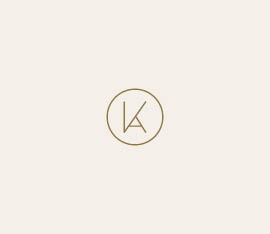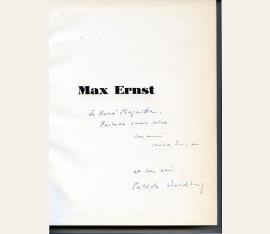Maler, Graphiker und Bildhauer (1891–1976). Collection of partly autograph documents and other material. Verschiedene Orte. Zusammen 47 Bll. Verschiedene Formate.
$ 13,343 / 12.500 €
(25372)
Most of the material relates to the sale of Ernst’s residency at Saint-Martin d’Ardèche in Southern France, where Ernst and Leonora Carrington (the British-born Mexican surrealist painter and novelist whom he had met in 1937) had lived from 1938 to 1941. The interior that both had created for their house was widely renowned as a masterpiece of materialized surrealist imagination (cf. Spies/Metken IV, p. VI). Due to the stress of circumstances (Ernst fled from German-occupied Europe in 1941), the sale was somewhat hasty, and the house was left as well as its whole inventory and decoration (cf.
catalogue of works, Spies/Metken, nos. 2304 ff.). – The present collection comprises letters from Ernst’s lawyer, inventories, a letter from Ernst wherein he cancels the electricity supply, a letter from the essayist Leon Kochnitzky (1892–1965) to Ernst, alarming him that the Germans had sequestrated three of his works at his Paris residency, 2 autogr. envelops, various letters and newspaper clippings, a photography, etc..
Maler (1891-1976). Autograph letter signed, illustrated with 2 small drawings. Sellains. 1 p. 4to. Mit gedr. Briefkopf „83 - Seillans“.
$ 2,348 / 2.200 €
(80443)
In this letter Max Ernst writes: „Merci, cher Makario ! de votre oeuvre ! accomplie ! merci !“ ("Thank you, dear Makario! for your work! accomplished! thank you!" With two small drawings typical for Max Ernst’s work. With the signature „Max et Dorothea Ernst“. The letter was written by Max Ernst geschrieben who also signed in place of Dorothea Tanning Max Ernst was a German-born prolific artist, who was a primary pioneer of the Dada movement and surrealism. He had no formal artistic training, but his experimental attitude toward the making of art resulted in his invention of frottage—a technique that uses pencil rubbings of objects as a source of images—and grattage, an analogous technique in which paint is scraped across canvas to reveal the imprints of the objects placed beneath.
He is also noted for his novels consisting of collages. The letter is possibly addressed to Macarion Vitalis (1898-1989). He is considered one of the most important Filipino artists of the 20th century. Vitalis moved to Paris in the mid-1920 where he met Picasso, and other important modern painters. Vitalis is noted for his post-impressionist and cubist style of painting. Seillans is a commune in the Provence-Alpes-Côte d'Azur region in southeastern France. n the late Sixties and early Seventies Max Ernst and Dorothea Tanning made Seillans their home..
Maler (1891-1976). Autograph inscription signed. In: Patrick Waldberg: Max Ernst. (Paris). 443, (5) SS. 4to. Leinen mit blindgepr. Rücken- und Deckeltitel.
$ 6,938 / 6.500 €
(33317/BN28340)
"À René Margritte. Prince san rire. / son ami / Max Ernst". With another inscription signed by the author Patrick Waldberg.
Maler (1891-1976). "Autophoto". Eigenh. Manuskript und eh. Brief mit U. "Max". Seillans. Zusammen 1¼ SS. und 1 Skizze auf 3 Bll. 4to. Mit eh. adressiertem Umschlag und einem Manuskript des Übersetzers Robert Valençay.
$ 4,803 / 4.500 €
(92153/BN60281)
Korrektur der französischen Übersetzung eines dadaistischen Selbstzeugnisses des Künstlers für die Schriftenausgabe "Écritures" (Paris, Gallimard, 1970), das ursprünglich 1921 unter dem Titel "Max Ernst" in der Zeitschrift "Das Junge Rheinland" erschienen war. Der Brief an den Übersetzer Robert Valançay ist unmittelbar der Übersetzung angefügt, die dieser Ernst übermittelt hatte. Ernst berichtet, dass er die Übersetzung nach der Rückkehr aus Italien, wo er sich "im Schlamm gewälzt hat", vorfand, und befindet diese als "nicht so schlecht" (Übs.); er habe sich aber "ein paar kleine Änderungen erlaubt".
Diese neue Version ist in Ernsts Hand auf einem separaten Blatt beigefügt. Auf einem dritten Blatt mit Anmerkungen Valençays zu dessen Übersetzung hat Ernst eine Skizze des Sternbilds Großer Bär angefertigt, in der die Sterne Alkor und Mizar benannt sind, die im Text Erwähnung finden. - Das "Selbstbildnis" erweckt zunächst den Anschein eines prahlerischen autobiographischen Texts, der jedoch bald durch dadaistische Elemente ad absurdum geführt wird. So verleiht sich Ernst den Spitznamen "Spitzer Hahnenfuß" und behauptet, dass er mit 12 Jahren das Elternhaus verlassen habe, "um den halbwüchsigen Eisenbahnen und den wichtigsten Seezungen nachzujagen". Der Text ist ein dadaistisches Kunstwerk eigenen Rechts, und Ernst nutzt seine Korrekturen der Übersetzung Valençays für weitere Variationen des Absurden. - Zwei Sätze, die als Beschreibung seiner künstlerischen Praxis von großem Interesse sind, durchlaufen besonders spannende Transformationen. Der deutsche Text "Seine Farbgebung ist manchmal durchlocht und manchmal röhrenförmig" wurde von Valençay möglichst verständlich mit "Son coloris est parfois percé de trous et parfois en forme de tuyaux" übersetzt. Ernsts Korrektur ist auf den ersten Blick originalgetreuer, doch dürfte es ihm vor allem an der Alliteration gelegen sein: "Son coloris est parfois perforé, parfois tubulaire." Besondere Schwierigkeit bereitete Valençay der Folgesatz: "Seine Stoffausscheidung ist voller Pflanzen und Tierreste", den er mit "Le matériau qu'il secrète est plein de plantes et de restes d'animaux" übersetzte und mit einer Anmerkung versah. Ernst wirft in seiner Überarbeitung jedoch die "Stoffausscheidungen" über den Haufen und ersetzt sie durch "concrétions". Diese Änderungen können als ironische Anspielung auf die Konkrete Kunst interpretiert werden, die Max Ernsts künstlerischer Praxis denkbar fern stand. Beim Satz "Das Weib ist ihm ein mit weißem Marmor belegtes Brötchen" wurde Ernsts Überarbeitung "Pour lui, la femme est un sandwich en marbre blanc" nicht für die französische Publikation des Textes übernommen, sondern Valençays wörtliche Übersetzung beibehalten. Erwähnenswert ist auch Ernsts Beharren auf der fehlerhaften Schreibweise "Aktor" (dt. im Original) bzw. "Actor" (Überarbeitung) statt des richtigen "Alcor" in Valençays Übersetzung. Als abschließendes Beispiel für Ernsts kreative Überarbeitung sei der letzte Satz genannt: Robert Valençay übersetzt das Original "Sein Wendekreis ist Blütenraub" mit "Son tropique est un pillage d'arbres en fleur", woraus bei Ernst der poetische Satz "Son tropique est le rapt du cérisiér fleuri" wird. - Wohlerhalten..
painter (1891-1976). Autograph letter signed twice ("Max Ernst"). Saint-Martin-d'Ardèche. 4to. 2 pp.
$ 4,803 / 4.500 €
(91376/BN60431)
Highly interesting letter to the collector and critic Christian Zervos, asserting that Ernst will not emigrate to the U.S., probably following his brief internment in France as an "undesirable foreigner" at the beginning of World War II. Ernst thanks Zervos for forwarding a letter from his son Jimmy and for some issues of the Cahiers d'Art, before inviting him and his wife Yvonne Marion to his house in Saint-Martin-d'Ardèche for the summer. Emigration to the U.S. was already on the table, but Ernst writes that he has "no desire to leave" his house and therefore "will not go to live in America", preferring to "live and work" in France.
In the second part of the letter, Ernst expresses his relief concerning the date of a coming exhibition in Zervos's art gallery MAI, as he much prefers "waiting until the fall" so as to "prepare a very beautiful exhibition in all tranquility". - The letter must have been written sometime between his release from French internment in Camp de Gurs around Christmas 1939 and the beginning of the German invasion of France. Soon into the German occupation, Ernst was arrested by the Gestapo but managed to escape. This time he would not return to his house in Saint-Martin-d'Ardèche, which his partner Leonora Carrington had "sold" to a neighbour for a bottle of cognac to save it from confiscation before fleeing herself. In this dangerous situation, Ernst accepted Peggy Guggenheim's offer to accompany her to New York. Jimmy Ernst had tried to secure U.S. visas for Max Ernst and his mother Luise Straus when they were interned in Gurs, but Straus would have had to remarry Ernst, which she refused to do. While Max Ernst obtained his visa in 1941, Luise Straus remained in France. She was deported to Auschwitz and murdered in 1944. - Traces of folds. Minor browning and three minimal tears to the upper margin..

painter, sculptor and graphic artist (1891–1976).
1 autograph letter signed and 1 typed letter signed. 4to. 2 pp. Enclosed is one handwritten envelope.
$ 2,669 / 2.500 €
(83299)
To Jean Leymarie of the Musée National d’Art Moderne in Paris. 1.6.1969 (ALS with signature „Max Ernst“): Autograph letter to Monsieur Jean Leymarie of the Musée National d’Art Moderne: „[…] Vous me faites grand plaisir de consentir à preter ‚Capricorne‘ pour Stockholm et Amsterdam et je vous remercie. Voici en „change de bons procédés“ le No. de ma retraite: le 41 à Seillans. Je vous prie de recommander aux emballeurs de prendre bons soins du con de Mme Capricorne. […]“ Max Ernst agrees to send his painting Capricorn to Amsterdam and to Stockholm.
He asks the packers to take good care of Mrs. Capricorn as she is very fragile. Capricorn was Max Ernst’s sculptural masterpiece, which he finished while living in Sedona, Arizona, where he lived with his wife Dorothea Tanning (1910-2012) from 1946 till 1953. They built the small, secluded house in the desert that they called Capricorn Hill. The plastic Capricorn came about when they got electricity and running water a year after they moved there. The concrete mixer they purchased was not only used to build houses. Max Ernst came into contact with the indigenous people, the Hopi, and studied their art. He was particularly interested in the kachina dolls and the ceremonial masks. He created a larger-than-life cement sculpture in 1948, inspired by folk art. When Chagall moved back to Europe in 1953 he took a copy of his work, which was the base for Capricorn. 8.3.1971 (typed letter with signature „Max Ernst“): […] J’étais enchanté de l’avant-propos que vous avez fait pour l’Orangerie. Je vous verrai surement dans cet endroit aux environs du 2 avril. Je me réjouis d’avance, de vous remercier de vive voix. […]“ Max Ernst writes that he was delighted with Jean Leymarie’s foreword for the Orangerie, he is looking forward seeing him in April to thank him in person. A retrospective of 104 works spanning the years 1920–1968, drawn entirely from the Menil Collection, toured Europe from 1970 to 1972 and also were shown at Musée de l'Orangerie. The opening of the exhibition in Paris was augmented with 44 pieces from various collations and opened on 2 April 1971, Max Ernst's 80th birthday..





